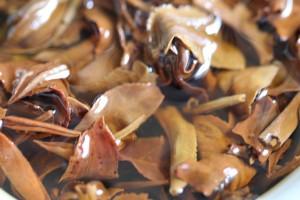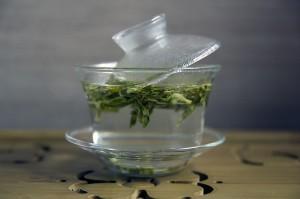For the purpose of this post, we shall refer to the tea plant as only those of the Camellia sinensis species. Even so, that is a complicated beast considering more than 1,000 varieties of teas are produced from that plant, in China alone.
Cultivar (树种)
Cultivar is simply ‘cultivated variety’, although technically this is in accurate since there are ‘naturally occurring cultivars’ – if you will excuse the oxy-moron- and ‘cultivated cultivars’- excuse the redundancy.
The Chinese equivalent of树种 is more accurately translated as tree species but as what is commonly understood as ‘species’ would be of C Sinensis sinensis & assamica. Not surprising since all the C Sinensis sinensis cultivated outside of East Asia traces its roots to Xingcun, northern Fujian.

For example, C sinensis assamica cv Menghai dayecha was first discovered in Menghai Nannuo Mountain. 100 buds of 1 bud to 3 leaves ratios weighs approximately 153.2g and has 7 to 8 petals when it blooms. Each mu of land produces approximately 200kg of tea.
In contrast, the C sinensis assamica cv Fengqing dayecha grown in Mengku province averages 119 g for 100 buds of the same ratio and the flower has 6-7 petals. Each mu of land produces approximately 140kg of tea.
(source:Cha Xue Gai Lu by Zhou Ju Gen et al)
These are just 2 of the numerous ‘naturally occurring cultivars’.
Then there are cultivars that are creations of the numerous tea research institutes and universities of China such as Longjing 43, Huang Guan Yin and so forth.
Variety (茶类)
The distinction of cultivar and variety is often blurred since very often, the name of the variety and the cultivar is the same.
The first instance that springs to mind is Tieguanyin (铁观音). It is the name of both the cultivar (also known as Weiyinzhong cultivar) and the variety of tea.
However, the same cultivar can also be made into different varieties.
Take the example of the Dabaicha (大白茶) cultivar. For starters, based on picking requirements and grades, it can be used to be processed into Silver Needles, White Peony and even Shoumei.
Further, the Dabaicha cultivar is also used to produce Bailin Gongfu, a type of black tea.
It doesn’t necessarily follow that varieties are subsets of cultivars though.

To add to the confusion, varieties can be further classified as sub-varieties based on location.
For example, Xihu Longjing, Dafo Longjing, Yuezhou Longjing and so forth. (For further reading on the different types of Longjing, you can read this post)
It can also be sub-divided based on harvest time.
i) Pre-Qing Ming Longjing
ii) Pre-Harvest Rain Longjing
iii) Spring Longjing
It can go further but let us look at another curious term- fir (丛).
Fir (丛)
This refers to a specific tree- or a collection of tree- from the same cultivar.
For example Dancong are from the Fenghuang Shuixian cultivar (which is distinct from the Fujian Shuixian cultivar).
From that cultivar, different firs or trees exhibit certain characteristics that form a distinct type of variety.
The various types of Dancong such as Mi Lan Xiang, Tong Tian Xiang, Huang Zhi Xiang, Xin Ren Xiang all trace their roots to a specific tree. (more on Dancong here)
Many of them have been grafted and cultivated elsewhere but exhibiting the traits of their parent tree.
Style (香型)
Next we look at the style, which is a function of the production technique, primarily by varying level of oxidation and roasting.
The common styles of oolong are qingxiang (清香) and nongxiang (浓香) which is lightly and heavily oxidized respectively.
This can refer to the same variety such as Tieguanyin but 2 markedly different tasting teas as I wrote about here.
Location
To add to the confusion, sometimes adding the geographical location changes things quite a bit and it’s not merely due to what I wrote here about the importance of origin.
As mentioned above, Fenghuang Shuixian and Fujian Shuixian are distinct cultivars, not merely the same cultivar grown in Fenghuang Mountain (Phoenix Mountain) and Fujian province respectively.
Just as Menghai, Mengku, Fengqing Dayezhong are all considered distinct cultivars with separate characteristics.
The same cultivar produced in different areas can be different recognized varieties as well.
For example, though Wuyi and Zhangping Shuixian are made from the same cultivar- Fujian Shuixian- they are distinct varieties that won’t be mistaken for each other.
A Parting Note
For fun, consider this, Taiwanese varieties of High Mountain Teas take on the names of their locations such as Alishan, Lishan, Shan Lin Xi.
More often than not they are of the Qing Xin cultivar although Jinxuan and Cuiyu cultivars have been used.
For instance our Alishan Oolong is of the Qing Xin cultivar while Alishan Jinxuan is of the Jinxuan cultivar, both distinct cultivars and varieties though they are of the same variety.
Then our Alishan Oolong leans towards qingxiang while our Shan Lin Xi is nongxiang though both are of the same cultivar but different varieties in different locations.
Is this confusing?
“My dear, if you could give me a cup of tea to clear my muddle of a head I should better understand your affairs.”~Charles Dickens
See other articles on Selection and Storage of Tea
